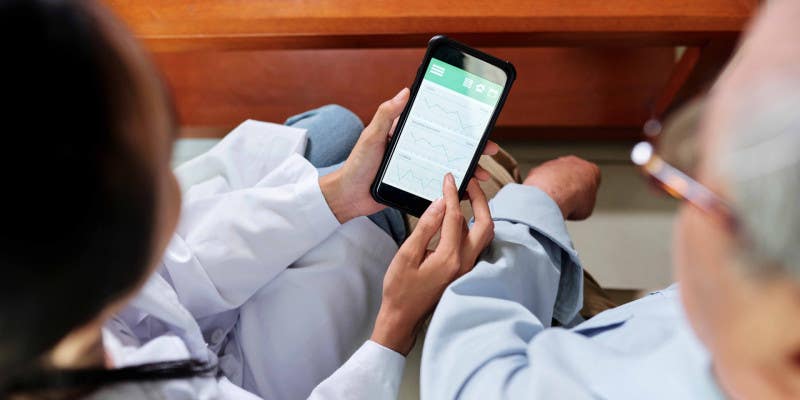Lifesaving smartphone app turns your phone into a blood pressure monitor
A smartphone app for blood pressure monitoring could make hypertension management more accessible, especially in underserved communities.

Researchers at the University of Pittsburgh have found a novel way to monitor blood pressure using a common device: the smartphone. Instead of creating a new medical tool, they aimed to use existing technology already in people's pockets. This innovative approach could make blood pressure monitoring accessible to those who lack traditional medical equipment.
Ramakrishna Mukkamala, a bioengineering professor at Pitt's Swanson School of Engineering, leads this effort. He believes smartphones can bridge gaps in healthcare, especially for underserved populations.
"The most significant thing you can do to reduce your risk of cardiovascular disease is to lower high blood pressure through lifestyle changes," Mukkamala says. "But in underserved populations, many people don't have access to blood pressure cuffs, regular doctor’s appointments, or even know it’s a problem. But they do have smartphones."
The team developed a smartphone application that uses the built-in sensors—such as the accelerometer, front camera, and touch sensors—to measure pulse pressure. Instead of a traditional blood pressure cuff, the user makes a hand-raising motion while holding the phone to determine pulse pressure, which is the difference between systolic (upper) and diastolic (lower) numbers. For example, if a person’s blood pressure reads 120/80, the pulse pressure is 40.
Vishaal Dhamotharan, a graduate student in the Cardiovascular Health Tech Laboratory, worked on this smartphone app, which was built for Android devices. One challenge the team faced was the lack of a force sensor in smartphones. They overcame this by using gravity as a substitute.
"Because of gravity, there's a hydrostatic pressure change in your thumb when you raise your hands above your heart, and using the phone’s accelerometer, you're able to convert that into the relative change in pressure," Dhamotharan explains.
By incorporating this motion with thumb movements guided by the phone, the app calculates pulse pressure accurately. This work, published in Scientific Reports, highlights the potential of using smartphones to monitor systolic hypertension, particularly in underserved populations.
Related Stories
The study, titled "A smartphone application toward detection of systolic hypertension in underserved populations," offers a glimpse of how this technology could ease the global burden of high blood pressure.
Sanjeev Shroff, a collaborator and chair of the bioengineering department at Pitt, sees the potential impact of the work. "Development of a cuffless blood pressure measurement device that does not require any external calibration is the holy grail—such a device currently does not exist. The research work reported in this publication is an important step in the right direction, and is also encouraging for additional work aimed at obtaining systolic, diastolic, and mean pressures," Shroff notes.
Currently, pulse pressure is not typically used as a standard metric in cardiovascular disease monitoring. However, the study suggests its value in identifying hypertension. Céderick Landry, assistant professor at the University of Sherbrooke and a former postdoctoral researcher at Pitt, underscores this point.
"Guidelines typically require doctors to measure both systolic and diastolic blood pressure, and pulse pressure is just the difference between the two," Landry says. "We showed that if you only have access to pulse pressure, it's still very correlated with hypertension, so part of our challenge now is changing the mentality on how to best measure things."
Hypertension, particularly systolic hypertension, is the leading modifiable risk factor for cardiovascular disease—the top cause of death worldwide. More than four billion adults globally suffer from high blood pressure.
Effective management often depends on early detection and consistent monitoring. This app allows anyone with a smartphone to track their pulse pressure regularly and easily share the data with healthcare providers.
Access to regular blood pressure checks is often challenging for people in low-income settings or underserved areas. The app's ability to turn a smartphone into a blood pressure monitoring tool could be crucial for communities without access to healthcare resources. Frequent monitoring can help track significant changes, allowing individuals to manage their conditions effectively.
Dhamotharan adds, "This app would be really useful in low-income settings where people may not even have existing access to blood pressure tools. Being able to measure blood pressure more frequently would allow an individual to track any significant changes in blood pressure, monitor for hypertension, and be able to manage their conditions with that knowledge."
In the United States, rural residents face a higher risk of heart disease than urban populations. Rural residents are about 40% more likely to develop heart conditions. By making blood pressure monitoring possible with just a smartphone, this technology has the potential to provide affordable healthcare tools in remote areas across the country and beyond.
Further development is needed to make this technology widely accessible, but the foundational research is promising. The team continues to refine the app to enhance its accuracy and ease of use. Looking forward, the researchers are optimistic about the technology’s potential impact.
"The research is here—we just need some help making the technology better," Landry emphasizes. "This is the first method of its kind, and even better, it’s something that we can start implementing right now."
In addition to bringing healthcare monitoring to underserved populations, this research aims to shift how blood pressure is tracked altogether. A smartphone-based solution could democratize healthcare by providing a reliable tool that is easily available to millions of people.
With improvements, this innovation could prove invaluable in addressing global health challenges linked to cardiovascular diseases, saving lives through early detection and regular self-monitoring.
Note: Materials provided above by The Brighter Side of News. Content may be edited for style and length.
Like these kind of feel good stories? Get The Brighter Side of News' newsletter.



